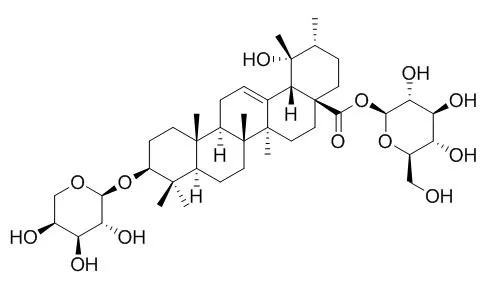| In vitro: |
| Biosci Biotechnol Biochem. 2008 Feb;72(2):303-11. | | Anti-wrinkle activity of ziyuglycoside I isolated from a Sanguisorba officinalis root extract and its application as a cosmeceutical ingredient.[Pubmed: 18256460] | In order to investigate the potential of a Sanguisorba officinalis root extract as an active ingredient for wrinkle-care cosmetics, we measured its free radical scavenging activity, elastase inhibitory activity, expression of MMP-1 (matrix metalloprotease-1) in vitro, and type I collagen synthesis in normal human fibroblast cells.
METHODS AND RESULTS:
To isolate the main components from the S. officinalis root extract, we purified the extract by solvent fractionation, column chromatography, and recrystallization. The active component was identified as Ziyuglycoside I by a spectroscopic analysis. Ziyuglycoside I increased the expression of type I collagen in a dose-dependent manner (by up to 71.3% at 50 muM). A clinical study of a formulation containing Ziyuglycoside I, which involved visual evaluation and image analysis, showed a significantly different effect (p<0.05) of the test formulation from that of the placebo.
CONCLUSIONS:
This result suggests that Ziyuglycoside I isolated from S. officinalis root extract could be used as an active ingredient for cosmetics. | | Int J Mol Sci . 2016 Nov 22;17(11):1903. | | Ziyuglycoside I Inhibits the Proliferation of MDA-MB-231 Breast Carcinoma Cells through Inducing p53-Mediated G2/M Cell Cycle Arrest and Intrinsic/Extrinsic Apoptosis[Pubmed: 27879682] | | Abstract
Background: Due to the aggressive clinical behavior, poor outcome, and lack of effective specific targeted therapies, triple-negative breast cancer (TNBC) has currently been recognized as one of the most malignant types of tumors. In the present study, we investigated the cytotoxic effect of Ziyuglycoside I, one of the major components extracted from Chinese anti-tumor herbal Radix Sanguisorbae, on the TNBC cell line MDA-MB-231.
Methods: The underlying molecular mechanism of the cytotoxic effect Ziyuglycoside I on MDA-MB-231 cells was investigated with cell viability assay, flow cytometric analysis and Western blot.
Results: Compared to normal mammary gland Hs 578Bst cells, treatment of Ziyuglycoside I resulted in a significant growth inhibitory effect on MDA-MB-231 cells. Ziyuglycoside I induced the G2/M phase arrest and apoptosis of MDA-MB-231 cells in a dose-dependent manner. These effects were found to be partially mediated through the up-regulation of p53 and p21WAF1, elevated Bax/Bcl-2 ratio, and the activation of both intrinsic (mitochondrial-initiated) and extrinsic (Fas/FasL-initiated) apoptotic pathways. Furthermore, the p53 specific siRNA attenuated these effects.
Conclusion: Our study suggested that Ziyuglycoside I-triggered MDA-MB-231 cell cycle arrest and apoptosis were probably mediated by p53. This suggests that Ziyuglycoside I might be a potential drug candidate for treating TNBC.
Keywords: G2/M phase arrest; MDA-MB-231 cell line; intrinsic and extrinsic apoptosis; Ziyuglycoside I. |
|






 Cell. 2018 Jan 11;172(1-2):249-261.e12. doi: 10.1016/j.cell.2017.12.019.IF=36.216(2019)
Cell. 2018 Jan 11;172(1-2):249-261.e12. doi: 10.1016/j.cell.2017.12.019.IF=36.216(2019) Cell Metab. 2020 Mar 3;31(3):534-548.e5. doi: 10.1016/j.cmet.2020.01.002.IF=22.415(2019)
Cell Metab. 2020 Mar 3;31(3):534-548.e5. doi: 10.1016/j.cmet.2020.01.002.IF=22.415(2019) Mol Cell. 2017 Nov 16;68(4):673-685.e6. doi: 10.1016/j.molcel.2017.10.022.IF=14.548(2019)
Mol Cell. 2017 Nov 16;68(4):673-685.e6. doi: 10.1016/j.molcel.2017.10.022.IF=14.548(2019)